- Home
- David R. George III
Crucible: Kirk Page 18
Crucible: Kirk Read online
Page 18
While Kirk waited, he pressed a control that slid the protective shielding from the forward viewports, affording him a view of the hangar door. Thirty seconds passed. Sixty seconds. Ninety.
On the panel before him, an indicator detected a resonance burst emerging from the ship’s main deflector. Kirk immediately touched a button, which would initiate thirty seconds later the condition for the playback of his recorded message. He then moved at once to the rear compartment, where he dropped to his knees and quickly triggered the maximum overload setting on each of the six phasers. Once he’d done that, he stood and performed a transport.
On the pad, the weapons disappeared in a nimbus of blue-white light. A glance through the forward viewports showed them materializing in the shuttlebay. Kirk then energized the transporter a second time.
As a halo of brilliant light formed in the air before him, he could only hope that he’d planned all of this well enough.
Jim Kirk found the ladder leading down into the maintenance corridor. He descended into the bowels of the ship and hurried forward, striving to keep his footing as the Enterprise continued to quake. Coolant leaks hissed in the enclosed space, intermittently sending up eruptions of vapor from rents in the bulkhead. Kirk raced through the clouds, feeling their cold touch.
Reaching the primary deflector control center, Kirk entered through its wide doors. Here too a fog of coolant blurred the air. Just a glance down into the compartment showed him where he needed to go. He climbed down a ladder to a walkway and removed the grating that covered the access to the main deflector relays. The ship reeled again, and the grate slipped from his hands and fell at least ten meters, rattling along the bulkheads as it did. Down another ladder, and at last he reached the main deflector control assembly. He opened the access plate and the relay emerged from behind it, automatically rising to situate itself beside the override panel. Kirk pulled himself back up the ladder and moved to the housing for the override. He opened the plate there to expose a series of optical chips utilized to program the main deflector. As quickly as he could, he chose the two that would allow him to do what he needed to do, and he started to reseat them in the circuit accordingly.
“Bridge to Captain Kirk,” he suddenly heard Scotty’s voice.
“Kirk here,” he called as he slid the second chip into the appropriate slot. He jabbed at the override controls, reprogramming the relay to permit the resonance burst.
“I don’t know how much longer I can hold her together,” Scotty said, a familiar plaint. In other, less serious circumstances, Kirk would’ve laughed.
He finished working at the control panel, then hastily backed up and bent down to the deflector control assembly. With both hands, he grabbed the safety and pulled it free. Stepping back to the override panel, he bent and rammed the mechanism into place.
“That’s it!” he called. “Let’s go!”
“Activate main deflector,” he heard Harriman order, his voice strong.
In the control center around Kirk, none of the equipment seemed to change, but he heard a loud whine that he knew must be the resonance burst. Even as the ship shook, he could feel it steadying by degrees, the feel of the drive becoming less labored.
“We’re breakin’ free,” Scotty said.
The drone of the resonance burst ceased and the control center quieted dramatically. Kirk detected a change in the movement of the ship. He could never have described the sensation, but he had spent enough time aboard starships to recognize the change in attitude. He knew at that moment that this Enterprise and this crew would be safe.
Kirk started away from the deflector equipment, moving back along the walkway toward the ladder up. He reached it and began to climb, but then stopped. In the relative calm of the primary deflector control center, Kirk suddenly heard a familiar sound, its presence here and now making no sense to him.
Suddenly he saw bright blue-white light arising before his eyes, clouding his vision. He knew that he’d been caught in a transporter beam, but he had no idea why. Before him, the outer bulkhead vanished.
Then so did he.
SIXTEEN
2293
Jim Kirk materialized on a small transporter pad in a cramped space. He looked around, then stepped down and walked through the compartment’s only exit. He found himself in what appeared to be the main cabin of a Starfleet shuttlecraft, though of a class he’d never before seen.
The deck moved beneath him, in the same relatively sedate manner that the Enterprise had as the resonance burst had broken the ship free of the energy ribbon. Kirk peered forward to the front of the craft, where through the viewports he saw a starship’s hangar deck. He could understand why Harriman or Scotty or somebody else aboard the Enterprise would have transported him out of the deflector control room, since he’d seen the outer bulkhead breached just as he’d been beamed away. What he could not fathom is why he would be brought to a shuttle sitting in the ship’s hangar. If he—
A bright flash of light suddenly flared through the viewports and a loud explosion filled the air. Kirk felt the concussion against the hull of the shuttle. It continued one second after another, and as he toppled to the deck, he couldn’t tell whether the detonation was one long blast or several shorter ones. When finally the deafening noise quieted, he felt the shuttle shift beneath him, as though lifting off.
Kirk quickly scrambled to his feet and raced to the bow. Through the viewports he saw that half of the hangar door had been obliterated, exposing the shuttlebay to space. Intermittent blue sparks there indicated that an emergency force field had snapped into place. That should have prevented the shuttle from being blown out through the opening, but still it moved toward the missing half of the door.
Peering down at the console, Kirk searched the controls and readouts for the craft’s status. Just as the shuttle hurtled from the Enterprise’s hangar, he saw what had happened: the antigravs had been charged and had carried the small vessel forward and into space. He looked up again and saw in the distance the whirling, thrashing form of the energy ribbon, but the shuttle, seemingly undirected, tumbled through the void, and he soon lost sight of the deadly phenomenon. Fortunately, the ribbon had appeared headed away from his location, but he would take no chances. Kirk sat down at the console and began working to take control of the shuttle.
“Jim,” a voice suddenly said, and Kirk looked to the left to see his own image on a viewscreen. “Please watch this entire message before taking any action—before engaging the shuttlecraft’s engines or opening communications with the Enterprise.” Kirk stared at himself, knowing that he had never made such a recording. The man on it looked just like him, and even wore the white shirt and crimson vest of a Starfleet uniform. “I’ve locked down all of the controls in the shuttle, but I know that you’re resourceful enough to free them if you try. I’m asking you to listen to me first. At the completion of this message, you’ll find the shuttle released to your command.”
Kirk glanced down and reached across the panel to an engine control. When he touched it, it issued a short buzz, indicating its inactive state. “I’ve programmed the thrusters and tied them into the sensors,” the recording continued. “Should the shuttle near the energy ribbon, the thrusters will engage to keep the craft safe.” Gazing again through the viewports, Kirk saw the energy ribbon return to view as the shuttle continued to spin through space, but the phenomenon seemed farther away now.
“I am you,” the message went on, “but from a future date. To make and leave you this recording, I arrived here through the Guardian of Forever.” Kirk felt a jolt at the mention of the time vortex. “Because I am you, I know what the mere mention of the Guardian does to you, even after all these years.” The simple observation, the way it had been phrased, compelled Kirk to believe what he was being told. He continued to watch the recording.
“I also know that you think the Guardian was destroyed by the Klingons. I’ll explain that. But first, know that I lived through the events that you just
experienced: the christening and launch of the new Enterprise, the unexpected distress call from the two transports, beaming aboard forty-seven of the Lakul’s passengers, the destruction of the two ships within the energy ribbon, and then the Enterprise becoming trapped herself.” Kirk noted the accurate rundown of the day’s occurrences, sure that it too had been intended to convince him of the claims being made. “Based on a theory advanced by Scotty,” said his alleged future self, “you went to the deflector control room and overrode the safeties to permit a resonance burst to be generated from the main deflector. That broke the hold of the ribbon’s gravimetric field on the ship, but then a surge of energy ripped through the hull of the Enterprise, including punching a hole in the outer bulkhead of the deflector control room.”
“And that,” proclaimed this other Kirk, “was where the paths of our lives diverged. Unlike you, I was not transported to safety, but pulled into the energy ribbon, which it turns out is a gateway to a place called the nexus. I can best describe this place as a timeless dimension of the mind, though it must also have a physical component to it, since my body survived within it.” The other Kirk then described his experiences within the nexus, ending when he’d met another captain of another Enterprise from the year 2371. “Picard reminded me how much I wanted to make a difference,” he said. He told of how he had then left the nexus and come back to this universe in order to help that captain, Picard, prevent a madman named Soran from destroying the star Veridian and incinerating two hundred thirty million people. They had succeeded, stopping Soran on Veridian Three, but in returning to normal space, Kirk’s presence had, by virtue of the significant buildup of chronometric particles in his body, triggered something he called a converging temporal loop, which he then explained. He had been swept back into the nexus, but in this universe, vast tracts of time and space had been destroyed.
“And so I left the nexus again,” the other Kirk said, “this time to the Guardian of Forever, five billion years in the past—before our sun burned hot in space.” Kirk recognized the quote. “I came through the Guardian to this time by traveling backward through my own life. My intention was to find a way to prevent the converging loop without imperiling either the crew of the Enterprise-B or the population of Veridian Four, and without altering the timeline.” Kirk understood well the necessity of avoiding changes to history.
“Now, if you’re hearing this message, it means that I am no longer aboard the shuttle, but more important, it means that I have succeeded in preventing the destructive temporal loop. Because you did not enter the nexus, you did not leave it, and so you and your set of chronometric particles did not exist at two distinct points in time and space that were connected by the conduit of the nexus. Because I transported you to safety after you saved the Enterprise and her crew, that is no longer an issue either.
“But after the ship’s encounter with the energy ribbon, you were presumed dead,” the recording went on. “To avoid altering history, that must continue to be true. Using specific deflector frequencies, I hid your transport out of the deflector control room. I also simulated an explosion on the hangar deck as though it had been caused by the energy ribbon. The shuttle is now tumbling through space. Because of the deflector frequency, the Enterprise crew will be unable to scan it for life signs, although they would not expect there to be any, since it appears to them as though the hangar deck had been breached and a shuttle blown out into space. As you know, the ship has no tractor beam to haul the shuttle back aboard. Should the crew attempt to beam it aboard, they’ll find it impossible to fix a transporter lock on it because of the deflectors, though they will most likely attribute it to interference from the energy ribbon. They might intend to come back for the shuttle later, but for now they will leave it and head back to Earth so that the survivors of the Lakul can receive medical treatment.”
Well planned, Kirk thought.
“But there is still action to be taken,” the message continued. “Because you never entered the nexus, you will never meet Picard and never leave with him to stop the destruction of the Veridian star in the year twenty-three seventy-one. You must employ another means to do this, while at the same time averting any alteration to the timeline between now and then.” The other Kirk paused, then said, “This is why I traveled to the Guardian. I know how you can do this.”
Kirk listened as his counterpart explained his plan. After that, the future Kirk listed a number of details about his life—about their life—in an attempt to further prove his identity. He talked about the first time he had ever traveled by transporter, on the occasion of his grandfather’s funeral, and how it had seemed to him that the universe had dissolved around him, moved, and then re-formed. He mentioned what he had done in those solitary moments after learning of his father’s death. He detailed how, in ancient caverns on the planet Vulcan, he had mourned his son David. And perhaps most convincing of all, he had spoken with difficulty about the private moments he had shared with Edith, moments that he had held close throughout the years.
After the recording had concluded, the forward console came to life. Kirk tapped at the gravity regulator and immediately felt a reduction in his apparent weight, confirming that the controls had, as promised, been unlocked. Before he did anything more, though, he sat quietly, attempting to process all that he had been told. Among other things, he wondered what had happened to his future self. According to the message, he had been aboard this shuttle when he’d transported Kirk out of the deflector control room, but he was not here now. Kirk imagined the sequence of events and their consequences. Because he had not been pulled from the Enterprise and into the nexus, he had also never exited the nexus, either to help Picard or to arrive on the world of the Guardian. He therefore had never leaped through the temporal vortex to the present, and so his future self no longer existed in this time period.
But then why didn’t the recording cease to exist now too? Kirk asked himself, but he then gave the matter little thought. He knew well that the apparent paradoxes of time travel and the mysterious functioning of the Guardian of Forever often defied explanation. Instead, he really needed to concentrate on what he would do next. That, of course, depended on whether or not he believed the content of the message.
He decided that he did.
He looked down at the console and reached forward to work the passive sensors. He saw that the energy ribbon had now moved away from his location, and that the Enterprise had now departed the scene, no doubt heading back to Earth, just as the recording had suggested would happen.
Cautiously at first, Kirk operated the helm, steadying the shuttle and engaging its impulse drive. Once he had moved away from the site where the Enterprise had encountered the energy ribbon, he plotted a course and took the shuttle to warp. Behind him, he realized, lay a life of joy and pain, of success and failure, a life that Scotty and Chekov and the crew of the new Enterprise-B now believed had been lost.
Ahead of him lay the Guardian of Forever.
SEVENTEEN
2293
Kirk worked the helm controls of the shuttlecraft—the Archimedes, he had learned during his voyage—and brought it down through the cloud cover. Below extended the dull plain of this ancient, barren world. Fissures and rock formations appeared here and there, breaking up the otherwise-featureless surface.
The journey to this planet had taken weeks. Kirk had traveled well away from normal starship routes and shipping lanes, periodically setting down on some empty moon or asteroid. His goal had been to move through space unobserved, thus avoiding making any alterations to the timeline. He’d also throttled the shuttle back to impulse power a number of times in an attempt to mask his trail.
Up ahead, Kirk saw the horizon drop away. He checked the sensors and read the measurements of the crater. It descended to a depth of two hundred meters and stretched a kilometer in diameter. Here, twenty-three years earlier, while Kirk had lain comatose in a turbolift aboard the Enterprise, Korax had taken his own wounded starsh
ip and raced through the atmosphere, intent on laying waste to what he believed to be the site of a new Starfleet weapon. Instead, the Klingon commander had destroyed—or killed—the Guardian of Forever.
Or at least, so Kirk had thought. So everybody had thought. But on the recording that had brought him here now, Kirk’s future self had revealed that when he’d left the nexus the second time and visited this place billions of years in the past, he had told the Guardian of its demise. More than that, he had asked both for its help and for it to save itself. It had seemed only reasonable to the future Kirk that a time portal would be able to move itself through time, and he had warned the Guardian to do just that before Korax’s ship reached the surface of this world. He had also requested that when it did so, it moved itself to now, to the days after the Enterprise had encountered the energy ribbon. Kirk, his future self had hoped, would then be able to use the Guardian to complete his plan.
The shuttlecraft Archimedes flew past the raised rim of the crater and out over the wide hollow. Within, the depression seemed empty, devoid of any characteristics beyond the radial lines reaching out from its center. The place seemed as dead as the rest of this haunted world.
Kirk performed a sensor sweep. He found no life signs, but he also scanned in particular for waves of time displacement, a singular trait of the Guardian. He studied the area within the crater itself and then out beyond that, to the limits of the sensors.
He detected nothing.
Kirk brought the Archimedes down, following along the rounded slope. Near the center of the crater, he landed the shuttle. Before disembarking, he went to the rear compartment and retrieved a tricorder. He hesitated for a moment, then pulled out a phaser as well.

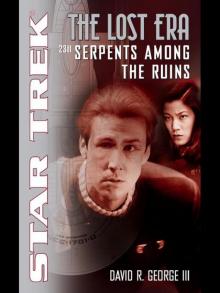 Serpents Among the Ruins
Serpents Among the Ruins The Fire and the Rose
The Fire and the Rose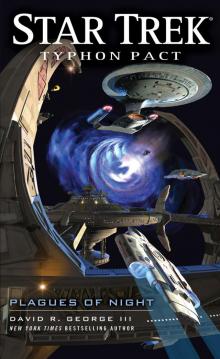 Star Trek: Typhon Pact 06: Plagues of Night
Star Trek: Typhon Pact 06: Plagues of Night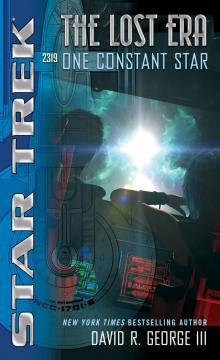 Star Trek: The Lost Era - 08 - 2319 - One Constant Star
Star Trek: The Lost Era - 08 - 2319 - One Constant Star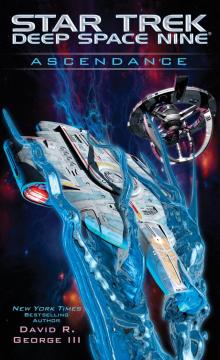 Star Trek: Deep Space Nine: Ascendance
Star Trek: Deep Space Nine: Ascendance Star Trek: TOS: Allegiance in Exile
Star Trek: TOS: Allegiance in Exile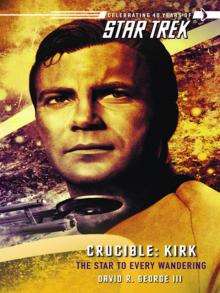 Crucible: Kirk
Crucible: Kirk Crucible: McCoy
Crucible: McCoy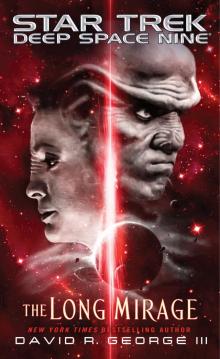 The Long Mirage
The Long Mirage Original Sin
Original Sin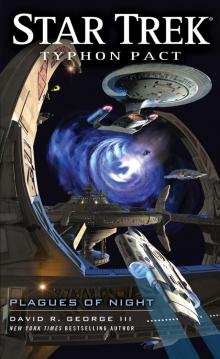 Star Trek: Typhon Pact: Plagues of Night
Star Trek: Typhon Pact: Plagues of Night Allegiance in Exile
Allegiance in Exile Sacraments of Fire
Sacraments of Fire Star Trek: Typhon Pact: Rough Beasts of Empire
Star Trek: Typhon Pact: Rough Beasts of Empire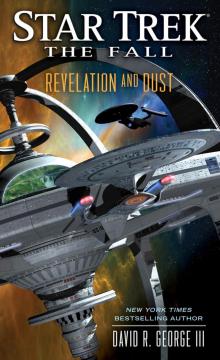 Star Trek: The Fall: Revelation and Dust
Star Trek: The Fall: Revelation and Dust